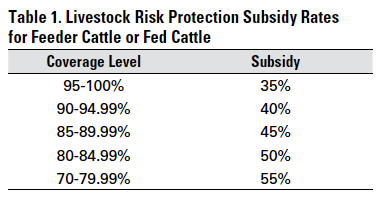Recognizing Livestock Threat Protection (LRP) Insurance: A Comprehensive Guide
Browsing the realm of animals risk security (LRP) insurance policy can be an intricate endeavor for several in the farming field. This sort of insurance policy offers a safety and security internet versus market changes and unexpected conditions that could affect animals producers. By recognizing the intricacies of LRP insurance policy, manufacturers can make educated choices that may secure their operations from monetary risks. From just how LRP insurance coverage works to the various protection choices readily available, there is much to uncover in this extensive overview that can possibly form the way livestock producers approach danger administration in their businesses.

Exactly How LRP Insurance Coverage Functions
Occasionally, recognizing the mechanics of Livestock Danger Defense (LRP) insurance can be complex, however breaking down how it works can supply quality for farmers and herdsmans. LRP insurance policy is a risk management device made to secure livestock manufacturers against unanticipated cost decreases. The policy allows manufacturers to establish an insurance coverage level based upon their specific requirements, choosing the number of head, weight array, and insurance coverage price. When the plan is in location, if market rates fall listed below the insurance coverage cost, manufacturers can sue for the difference. It's essential to note that LRP insurance policy is not a profits warranty; instead, it focuses only on price danger defense. The insurance coverage period typically ranges from 13 to 52 weeks, giving flexibility for manufacturers to pick a duration that lines up with their production cycle. By using LRP insurance, ranchers and farmers can alleviate the monetary threats related to rising and fall market prices, making sure higher stability in their procedures.
Eligibility and Insurance Coverage Options

When it comes to coverage choices, LRP insurance offers manufacturers the versatility to select the insurance coverage degree, protection period, and endorsements that finest match their risk administration demands. By recognizing the eligibility requirements and insurance coverage options offered, animals producers can make enlightened choices to handle risk efficiently.
Benefits And Drawbacks of LRP Insurance
When evaluating Animals Threat Security (LRP) insurance coverage, it is necessary for livestock producers to weigh the benefits and negative aspects integral in this danger management device.

One of the main benefits of LRP insurance coverage is its ability to offer security against a decline in livestock costs. Furthermore, LRP insurance coverage offers a degree of adaptability, enabling manufacturers to personalize insurance coverage levels and policy periods to match their details demands.
However, there are also some drawbacks to consider. One limitation of LRP insurance is that it does not protect against all kinds of threats, such as illness break outs or natural disasters. Additionally, premiums can sometimes be pricey, especially for producers with large livestock herds. It is important for producers to meticulously assess their specific danger exposure and economic circumstance to identify if LRP insurance coverage is the ideal danger administration tool for their procedure.
Understanding LRP Insurance Coverage Premiums

Tips for Maximizing LRP Perks
Making best use of the benefits of Animals Risk Protection (LRP) insurance policy requires critical planning and proactive danger management - Bagley Risk Management. To make the many of your LRP protection, take into consideration the complying with ideas:
Consistently Examine Market Conditions: Keep informed regarding market patterns and cost changes in the animals sector. By keeping an eye on these variables, you can make informed choices concerning when to acquire LRP insurance coverage to safeguard against prospective losses.
Set Realistic Protection Levels: When selecting coverage degrees, consider your manufacturing expenses, market value of livestock, and potential threats - Bagley Risk Management. Establishing sensible insurance coverage degrees ensures that you are effectively shielded without paying too much for unneeded insurance
Expand Your Protection: Rather than counting only on LRP insurance policy, think about diversifying your risk management strategies. Incorporating LRP with various other risk management tools such as futures agreements or choices can supply comprehensive coverage versus market uncertainties.
Evaluation and Change Insurance Coverage Regularly: As market conditions transform, occasionally review your LRP coverage to guarantee it straightens with your existing threat exposure. Changing protection degrees and timing of acquisitions can help maximize your danger protection method. By following these pointers, you can make best use of the benefits of LRP insurance and secure your livestock operation versus unforeseen dangers.
Conclusion
Finally, livestock visit here danger defense (LRP) insurance is a useful tool for farmers to handle the financial threats associated with their animals operations. By understanding exactly how LRP works, eligibility and coverage choices, in addition to the advantages and disadvantages discover here of this insurance, farmers can make educated choices to shield their incomes. By thoroughly taking into consideration LRP costs and executing approaches to make best use of benefits, farmers can mitigate prospective losses and guarantee the sustainability of their procedures.
Livestock producers interested in acquiring Livestock Danger Defense (LRP) insurance can explore a variety of qualification standards and coverage options customized to their certain animals procedures.When it comes to coverage alternatives, LRP insurance coverage provides producers the versatility to select the insurance coverage degree, coverage period, and endorsements that ideal suit their risk monitoring needs.To realize the complexities of Animals Threat Security (LRP) insurance policy fully, understanding the aspects affecting LRP insurance premiums is important. LRP insurance policy premiums are figured out by different aspects, consisting of the insurance coverage degree picked, the expected cost of animals at the end of the coverage period, the type of livestock being insured, and the length of the insurance coverage duration.Testimonial and Change Protection Frequently: As market conditions change, regularly review your LRP coverage to ensure it lines up with your existing threat direct exposure.